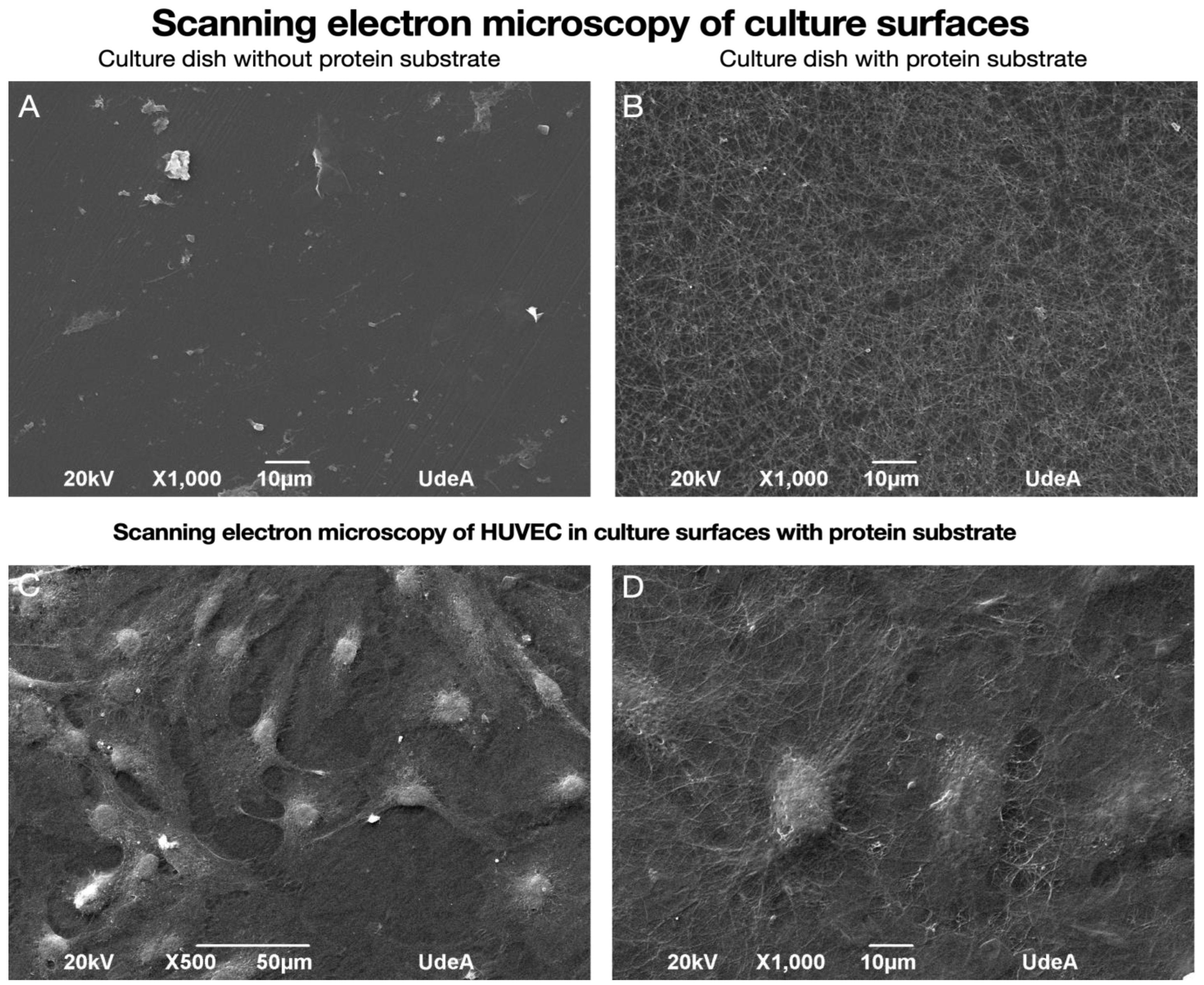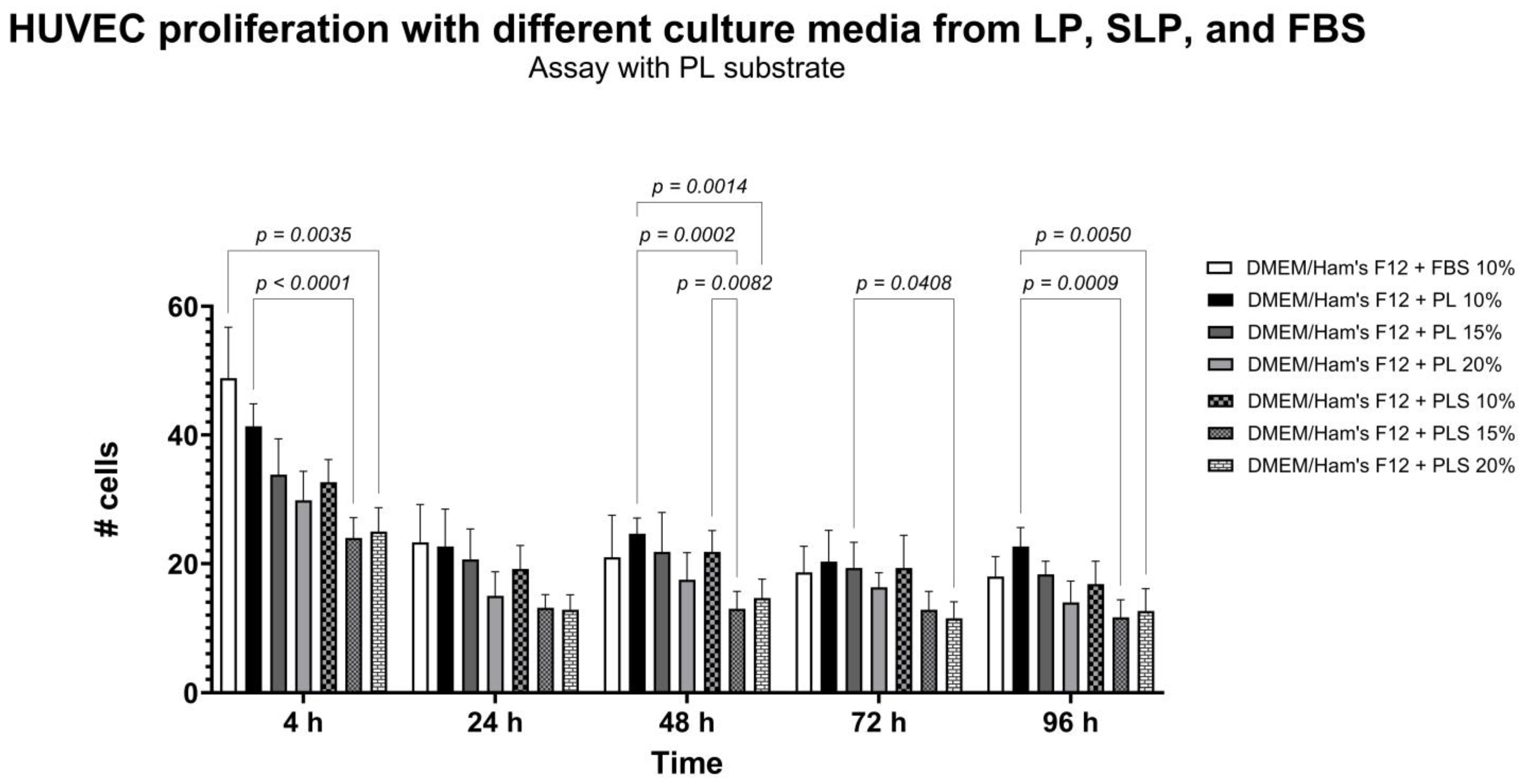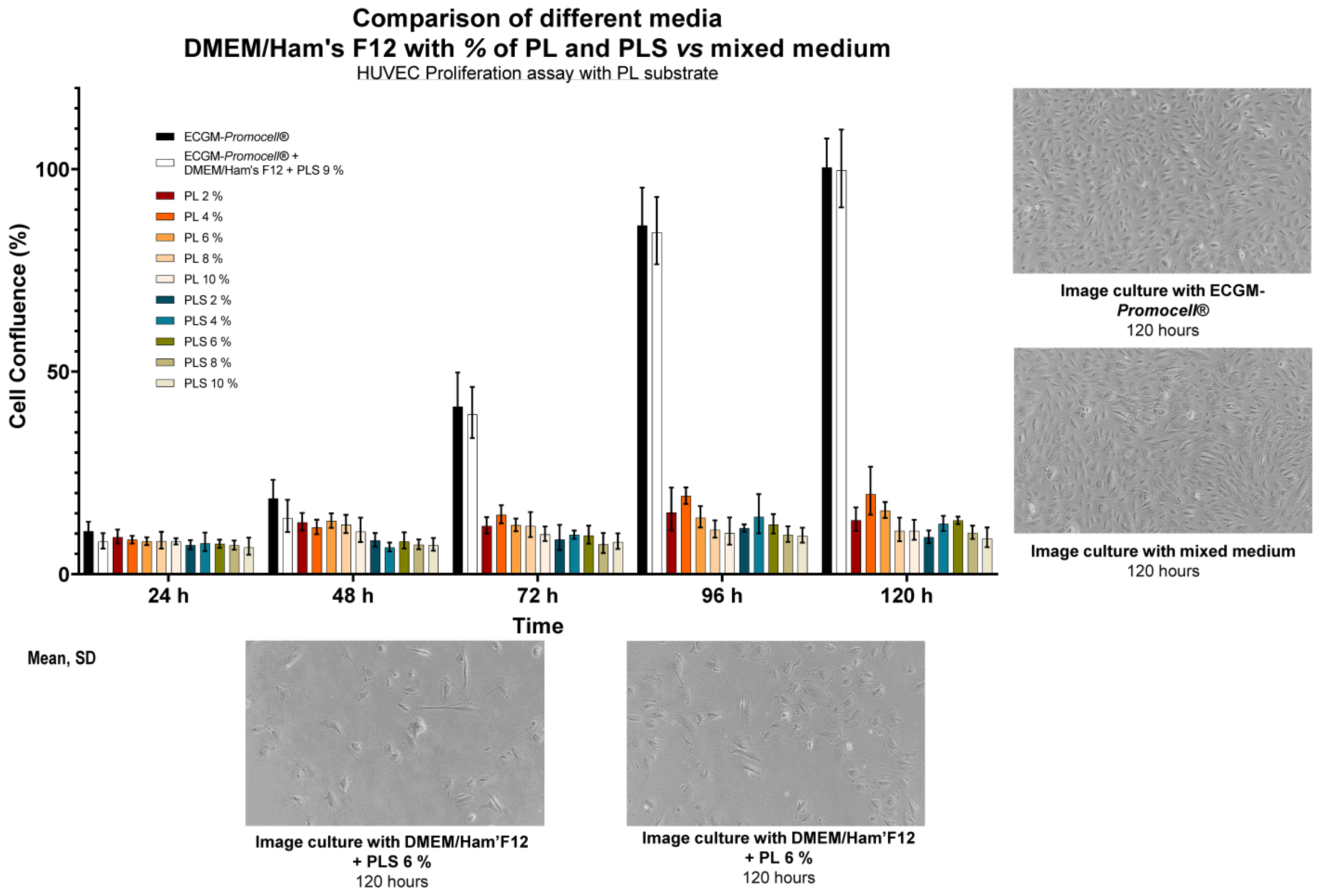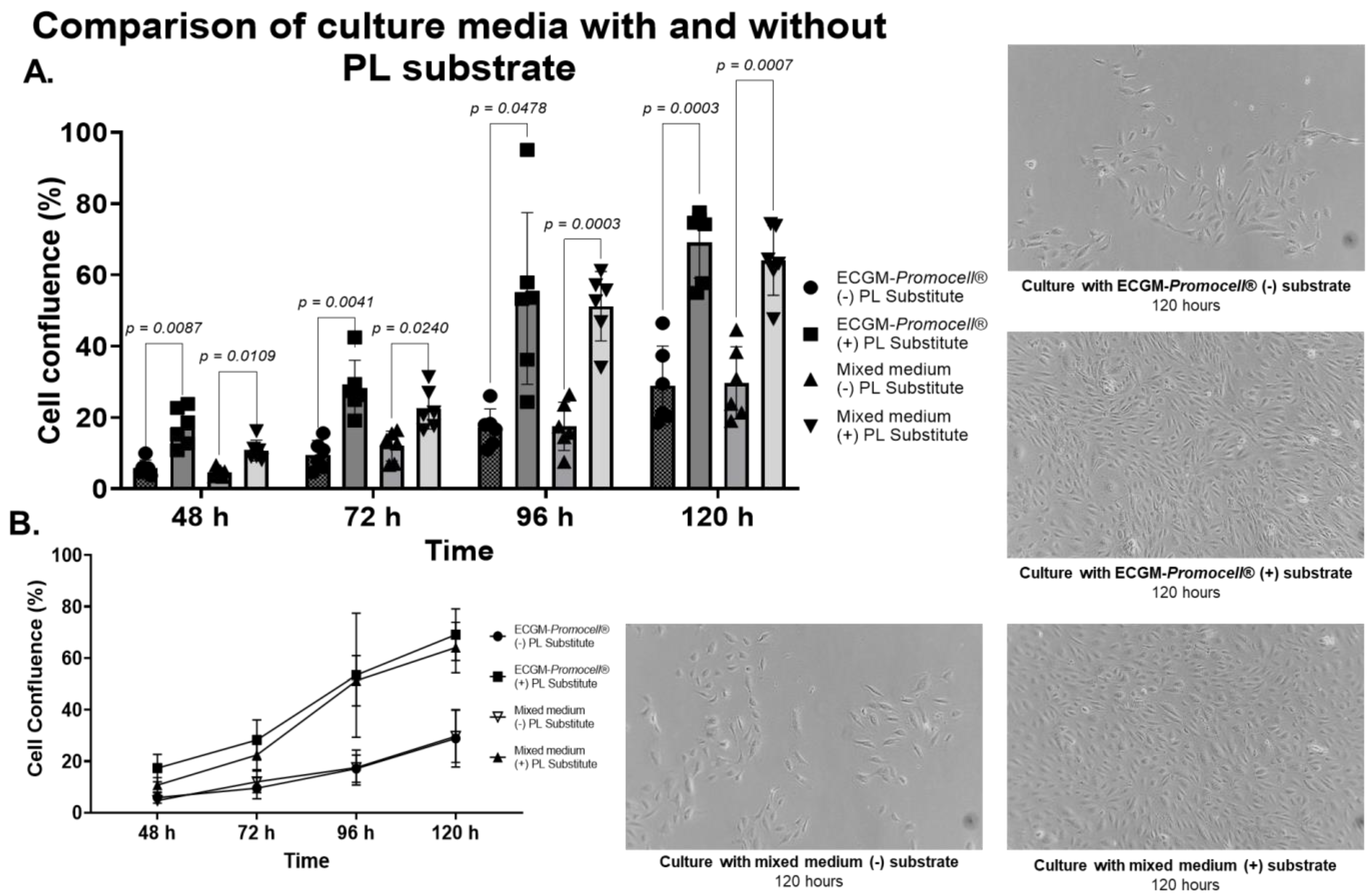Evaluation of Platelet Lysate-Based Medium and Protein Substrate for HUVEC Culture and Expansion
Abstract
1. Introduction
2. Materials and Methods
2.1. Obtaining and Preparation of PL and PLS
2.2. Analysis of Growth Factors and Cytokines in PL, PLS, and FBS Preparations
2.3. Proliferation Assays of HUVECs with ECGM-Promocell® Medium with and Without Protein Substrate
2.3.1. Preparation of HUVEC Culture Dishes
Scanning Electron Microscopy Evaluation of HUVEC Culture Dishes with and Without Protein Substrate
2.3.2. Isolation and Culture of HUVECs
2.3.3. Evaluation of the Effect of PL, PLS, and FBS Concentrations on HUVEC Proliferation
2.3.4. Evaluation of HUVEC Proliferation Using ECGM-Promocell® Medium and Different Culture Media with PL and PLS
2.3.5. Evaluation of the Effect of PLS Concentration on HUVEC Proliferation
2.3.6. Evaluation of the Effect of PL Substrate and Mixed Medium on HUVEC Phenotype
2.4. Analysis of Results
3. Results
3.1. PL and PLS Present Higher Concentrations of Growth Factors and Cytokines Compared to FBS and ECGM-Promocell®
3.2. The Use of a PL-Derived Protein Substrate Promotes Adhesion and Proliferation of HUVECs
3.3. The Use of Protein Substrate Generates a Basis for HUVEC Growth and Adhesion
3.4. FBS Standard Concentration in Culture Media Does Not Promote HUVEC Proliferation
3.5. HUVEC Culture with the Mixed Medium Is Similar Using ECGM-Promocell® Medium
3.6. Higher PLS Concentrations Do Not Enhance Cell Proliferation
3.7. Culture with PL Protein Substrate and Mixed Medium Does Not Affect the Phenotype and Morphology of HUVEC Cells
4. Discussion
5. Conclusions
Supplementary Materials
Author Contributions
Funding
Institutional Review Board Statement
Informed Consent Statement
Data Availability Statement
Acknowledgments
Conflicts of Interest
Glossary
| AdMSC | Adipose tissue-derived mesenchymal stem cells |
| DMEM | Dulbecco’s Modified Eagle Medium |
| EC | Endothelial cell |
| ECGM | Endothelial cell growth medium |
| EGF | Epidermal growth factor |
| FBS | Fetal bovine serum |
| FGF-b | Basic fibroblast growth factor |
| G-CSF | Granulocyte colony-stimulating factor |
| GM-CSF | Granulocyte-macrophage colony-stimulating factor |
| HUVEC | Human umbilical vein endothelial cells |
| IGF-1 | Insulin growth factor 1 |
| IL-6 | Interleukin 6 |
| IL-10 | Interleukin 10 |
| IL1RA | Interleukin-1 receptor antagonist |
| PDGF-AB | Platelet-derived growth factor isoform AB |
| PDGF-BB | Platelet-derived growth factor isoform BB |
| PL | Human platelet lysate |
| PLS | Human platelet lysate serum |
| RANTES | Chemokine regulating activation expressed and secreted by T lymphocytes. |
| TNF-α | Tumor necrosis factor-alpha |
| VEGF | Vascular endothelial growth factor |
| WJ-MSC | Wharton’s jelly-derived mesenchymal stem cells |
References
- Krüger-Genge, A.; Blocki, A.; Franke, R.P.; Jung, F. Vascular endothelial cell biology: An update. Int. J. Mol. Sci. 2019, 20, 4411. [Google Scholar] [CrossRef] [PubMed]
- Aird, W.C. Endothelial cell heterogeneity. Cold Spring Harb. Perspect. Med. 2012, 2, a006429. [Google Scholar] [CrossRef]
- Leopold, B.; Strutz, J.; Weiß, E.; Gindlhuber, J.; Birner-Gruenberger, R.; Hackl, H.; Appel, H.M.; Cvitic, S.; Hiden, U. Outgrowth, proliferation, viability, angiogenesis and phenotype of primary human endothelial cells in different purchasable endothelial culture media: Feed wisely. Histochem. Cell Biol. 2019, 152, 377–390. [Google Scholar] [CrossRef]
- Grant, D.; Wanner, N.; Frimel, M.; Erzurum, S.; Asosingh, K. Comprehensive phenotyping of endothelial cells using flow cytometry 2: Human. Cytometry Part A 2021, 99, 257–264. [Google Scholar] [CrossRef]
- Ribatti, D.; Tamma, R.; Ruggieri, S.; Annese, T.; Crivellato, E. Surface markers: An identity card of endothelial cells. Microcirculation 2020, 27, e12587. [Google Scholar] [CrossRef]
- Aird, W.C. Phenotypic Heterogeneity of the endothelium: I. Structure, function, and mechanisms. Circ. Res. 2007, 100, 158–173. [Google Scholar] [CrossRef] [PubMed]
- Baudin, B.; Bruneel, A.; Bosselut, N.; Vaubourdolle, M. A protocol for isolation and culture of human umbilical vein endothelial cells. Nat. Protoc. 2007, 2, 481–485. [Google Scholar] [CrossRef]
- Marin, V.; Kaplanski, G.; Grès, S.; Farnarier, C.; Bongrand, P. Endothelial cell culture: Protocol to obtain and cultivate human umbilical endothelial cells. J. Immunol. Methods 2001, 254, 183–190. [Google Scholar] [CrossRef] [PubMed]
- Medina-Leyte, D.J.; Domínguez-Pérez, M.; Mercado, I.; Villarreal-Molina, M.T.; Jacobo-Albavera, L. Use of human umbilical vein endothelial cells (HUVEC) as a model to study cardiovascular disease: A review. Appl. Sci. 2020, 10, 938. [Google Scholar] [CrossRef]
- Knedler, A.; Ham, R.G. Optimized medium for clonal growth of human microvascular endothelial cells with minimal serum. In Vitro Cell. Dev. Biol. Anim. 1987, 23, 481–491. [Google Scholar] [CrossRef]
- Fisher Scientific. GibcoTM MCDB 131 Medium, no Glutamine. Available online: https://www.fishersci.es/shop/products/mcdb-131-medium-no-glutamine/11513407 (accessed on 26 April 2023).
- Busch, C.; Rehak, M.; Hollborn, M.; Wiedemann, P.; Lang, G.K.; Lang, G.E.; Wolf, A.; Deissler, H.L. Type of culture medium determines properties of cultivated retinal endothelial cells: Induction of substantial phenotypic conversion by standard DMEM. Heliyon 2021, 7, e06037. [Google Scholar] [CrossRef] [PubMed]
- Millán, J.; Cain, R.J.; Reglero-Real, N.; Bigarella, C.; Marcos-Ramiro, B.; Fernández-Martín, L.; Correas, I.; Ridley, A.J. Adherens junctions connect stress fibres between adjacent endothelial cells. BMC Biol. 2010, 8, 11. [Google Scholar] [CrossRef]
- Pankajakshan, D.; Kansal, V.; Agrawal, D.K. In vitro differentiation of bone marrow derived porcine mesenchymal stem cells to endothelial cells. J. Tissue Eng. Regen. Med. 2013, 7, 911–920. [Google Scholar] [CrossRef] [PubMed]
- Zhu, D.D.; Tang, R.N.; Lv, L.L.; Wen, Y.; Liu, H.; Zhang, X.L.; Ma, K.L.; Liu, B.C. Interleukin-1β mediates high glucose induced phenotypic transition in human aortic endothelial cells. Cardiovasc. Diabetol. 2016, 15, 42. [Google Scholar] [CrossRef] [PubMed]
- Wang, R.; Xu, J.; Tang, Y.; Wang, Y.; Zhao, J.; Ding, L.; Peng, Y.; Zhang, Z. Transcriptome-wide analysis reveals the coregulation of RNA-binding proteins and alternative splicing genes in the development of atherosclerosis. Sci. Rep. 2023, 13, 1764. [Google Scholar] [CrossRef]
- Bala, K.; Ambwani, K.; Gohil, N.K. Effect of different mitogens and serum concentration on HUVEC morphology and characteristics: Implication on use of higher passage cells. Tissue Cell 2011, 43, 216–222. [Google Scholar] [CrossRef]
- Siow, R.C.M. Culture of human endothelial cells from umbilical veins. In Human Cell Culture Protocols; Mitry, R.R., Hughes, R.D., Eds.; Humana Press: Totowa, NJ, USA, 2012; pp. 265–274. [Google Scholar] [CrossRef]
- Burnouf, T.; Strunk, D.; Koh, M.B.C.; Schallmoser, K. Human platelet lysate: Replacing fetal bovine serum as a gold standard for human cell propagation? Biomaterials 2016, 76, 371–387. [Google Scholar] [CrossRef]
- Chelladurai, K.S.; Christyraj, J.D.S.; Rajagopalan, K.; Yesudhason, B.V.; Venkatachalam, S.; Mohan, M.; Vasantha, N.C.; Christyraj, J.R.S.S. Alternative to FBS in animal cell culture–An overview and future perspective. Heliyon 2021, 7, e07686. [Google Scholar] [CrossRef]
- Tekkatte, C.; Gunasingh, G.P.; Cherian, K.M.; Sankaranarayanan, K. “Humanized” Stem cell culture techniques: The animal serum controversy. Stem Cells Int. 2011, 2011, e504723. [Google Scholar] [CrossRef]
- Duarte Rojas, J.M.; Restrepo Múnera, L.M.; Estrada Mira, S. Comparison between Platelet Lysate, Platelet Lysate Serum, and Fetal Bovine Serum as Supplements for Cell Culture, Expansion, and Cryopreservation. Biomedicines 2024, 12, 140. [Google Scholar] [CrossRef]
- Jaffe, E.A.; Nachman, R.L.; Becker, C.G.; Minick, C.R. Culture of human endothelial cells derived from umbilical veins. Identification by morphologic and immunologic criteria. J. Clin. Investig. 1973, 52, 2745–2756. [Google Scholar] [CrossRef] [PubMed]
- Nachman, R.L.; Jaffe, E.A. Endothelial cell culture: Beginnings of modern vascular biology. J. Clin. Investig. 2004, 114, 1037–1040. [Google Scholar] [CrossRef]
- Akiyama, S.K. Integrins in cell adhesion and signaling. Hum. Cell 1996, 9, 181–186. [Google Scholar]
- Kadry, Y.A.; Calderwood, D.A. Chapter 22: Structural and signaling functions of integrins. Biochim. Biophys. Acta Biomembr. 2020, 1862, 183206. [Google Scholar] [CrossRef] [PubMed]
- Terramani, T.T.; Eton, D.; Bui, P.A.; Wang, Y.; Weaver, F.A.; Yu, H. Human macrovascular endothelial cells: Optimization of culture conditions. In Vitro Cell. Dev. Biol. Anim. 2000, 36, 125–132. [Google Scholar] [CrossRef]
- Kim, E.; Kim, J.J.; Hyon, J.Y.; Chung, E.S.; Chung, T.Y.; Yi, K.; Wee, W.R.; Shin, Y.J. The effects of different culture media on human corneal endothelial cells. Investig. Ophthalmol. Vis. Sci. 2014, 55, 5099–5108. [Google Scholar] [CrossRef]
- Hofbauer, P.; Riedl, S.; Witzeneder, K.; Hildner, F.; Wolbank, S.; Groeger, M.; Gabriel, C.; Redl, H.; Holnthoner, W. Human platelet lysate is a feasible candidate to replace fetal calf serum as medium supplement for blood vascular and lymphatic endothelial cells. Cytotherapy 2014, 16, 1238–1244. [Google Scholar] [CrossRef] [PubMed]
- Peters, K.; Helmert, T.; Gebhard, S.; Mailänder, V.; Unger, R.E.; Nezi-Cahn, S.; Hasenburg, A.; Heller, M.; Schwab, R.; Brenner, W. Standardized human platelet lysates as adequate substitute to fetal calf serum in endothelial cell culture for tissue engineering. BioMed Res. Int. 2022, 2022, 3807314. [Google Scholar] [CrossRef]
- Beekhuizen, H.; van Furth, R. Growth characteristics of cultured human macrovascular venous and arterial and microvascular endothelial cells. J. Vasc. Res. 1994, 31, 230–239. [Google Scholar] [CrossRef]
- Uriel, S.; Labay, E.; Francis-Sedlak, M.; Moya, M.L.; Weichselbaum, R.R.; Ervin, N.; Cankova, Z.; Brey, E.M. Extraction and assembly of tissue-derived gels for cell culture and tissue engineering. Tissue Eng. Part C Methods 2009, 15, 309–321. [Google Scholar] [CrossRef]
- Seeger, J.M.; Klingman, N. Improved endothelial cell seeding with cultured cells and fibronectin-coated grafts. J. Surg. Res. 1985, 38, 641–647. [Google Scholar] [CrossRef] [PubMed]
- Fortunato, T.M.; Beltrami, C.; Emanueli, C.; De Bank, P.A.; Pula, G. Platelet lysate gel and endothelial progenitors stimulate microvascular network formation in vitro: Tissue engineering implications. Sci. Rep. 2016, 6, 25326. [Google Scholar] [CrossRef] [PubMed]
- Kim, H.; Prasain, N.; Vemula, S.; Ferkowicz, M.J.; Yoshimoto, M.; Voytik-Harbin, S.L.; Yoder, M.C. Human platelet lysate improves human cord blood derived ECFC survival and vasculogenesis in three dimensional (3D) collagen matrices. Microvasc. Res. 2015, 101, 72–81. [Google Scholar] [CrossRef][Green Version]
- Hutchings, H.; Ortega, N.; Plouët, J. Extracellular matrix-bound vascular endothelial growth factor promotes endothelial cell adhesion, migration, and survival through integrin ligation. FASEB J. 2003, 17, 1–27. [Google Scholar] [CrossRef] [PubMed]








| Supplements | ||||
|---|---|---|---|---|
| PL | PLS | FBS | Promocell | |
| IGF-1 (ng/mL) | 7.364 ± 1.863 ***, ~~~ | 7.548 ± 1.227 ***, ~~~ | 0.000 ± 0.0 | 0.000 ± 0.0 |
| PDGF-AB (pg/mL) | 1697 ± 284.2 ***, ~~~ | 1813 ± 574.3 ***, ~~~ | 0.000 ± 0.0 | 0.000 ± 0.0 |
| b-FGF (pg/mL) | 1552 ± 104.0 ***, ~~~ | 1450 ± 126.1 ***, ~~~ | 0.000 ± 0.0 | 0.000 ± 0.0 |
| TGF-β1 (pg/mL) | 3660 ± 485.7 ***, ~~~ | 3780 ± 545.6 ***, ~~~ | 34.05 ± 20.40 | 0.000 ± 0.0 |
| EGF (pg/mL) | 1448 ± 320.6 ***, ~~~, +++ | 660.0 ± 183.5 ***, ~~~, +++ | 0.000 ± 0.0 | 0.000 ± 0.0 |
| Supplements | ||||
|---|---|---|---|---|
| PL | PLS | FBS | Promocell | |
| PDGF-AA (pg/mL) | 2468 ± 210.3 ***, ~~~ | 2483 ± 189.6 ***, ~~~ | 0.000 ± 0.0 | 4.93 ± 5.49 |
| VEGF (pg/mL) | 168 ± 26.3 ***, ~~~ | 164 ± 21.3 ***, ~~~ | 0.000 ± 0.0 | 8.67 ± 1.2 |
| G-CSF (pg/mL) | 18.6 ± 6.5 ***, ~~ | 12.9 ± 0.74 ***, ~~ | 0.000 ± 0.0 | 2.87 ± 0.1 |
| GM-CSF (pg/mL) | 2.4 ± 0.43 **, ~~ | 2.4 ± 0.51 **, ~~ | 0.000 ± 0.0 | 0.000 ± 0.0 |
| IL-10 (pg/mL) | 18.6 ± 5.86 **, ~~ | 22.3 ± 7.6 **, ~~ | 0.000 ± 0.0 | 0.000 ± 0.0 |
| IL-6 (pg/mL) | 48.5 ± 14.8 **, ~~ | 56.9 ± 13.5 **, ~~ | 0.000 ± 0.0 | 0.48 ± 0.3 |
| IL-1RA (pg/mL) | 25.2 ± 5.2 **, ~~ | 27.0 ± 6.8 **, ~~ | 0.000 ± 0.0 | 0.57 ± 0.1 |
| TNF-α (pg/mL) | 103.48 ± 2.05 **, ~~ | 96.25 ± 2.3 **, ~~ | 0.000 ± 0.0 | 0.000 ± 0.0 |
| RANTES (pg/mL) | 5537 ± 540.8 ***, ~~~ | 4500 ± 1461 ***, ~~~ | 0.000 ± 0.0 | 328.0 ± 348.4 |
Disclaimer/Publisher’s Note: The statements, opinions and data contained in all publications are solely those of the individual author(s) and contributor(s) and not of MDPI and/or the editor(s). MDPI and/or the editor(s) disclaim responsibility for any injury to people or property resulting from any ideas, methods, instructions or products referred to in the content. |
© 2025 by the authors. Licensee MDPI, Basel, Switzerland. This article is an open access article distributed under the terms and conditions of the Creative Commons Attribution (CC BY) license (https://creativecommons.org/licenses/by/4.0/).
Share and Cite
Duarte Rojas, J.M.; Restrepo Múnera, L.M.; Estrada Mira, S. Evaluation of Platelet Lysate-Based Medium and Protein Substrate for HUVEC Culture and Expansion. Biomedicines 2025, 13, 1187. https://doi.org/10.3390/biomedicines13051187
Duarte Rojas JM, Restrepo Múnera LM, Estrada Mira S. Evaluation of Platelet Lysate-Based Medium and Protein Substrate for HUVEC Culture and Expansion. Biomedicines. 2025; 13(5):1187. https://doi.org/10.3390/biomedicines13051187
Chicago/Turabian StyleDuarte Rojas, Juan Manuel, Luz Marina Restrepo Múnera, and Sergio Estrada Mira. 2025. "Evaluation of Platelet Lysate-Based Medium and Protein Substrate for HUVEC Culture and Expansion" Biomedicines 13, no. 5: 1187. https://doi.org/10.3390/biomedicines13051187
APA StyleDuarte Rojas, J. M., Restrepo Múnera, L. M., & Estrada Mira, S. (2025). Evaluation of Platelet Lysate-Based Medium and Protein Substrate for HUVEC Culture and Expansion. Biomedicines, 13(5), 1187. https://doi.org/10.3390/biomedicines13051187






